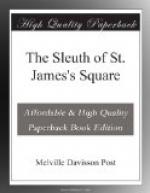“Of course, we don’t know conclusively who made it. Tony had gone in from the West coast after big game, and he found the thing put up as a sort of fetish in a devil house. It was one of the tribes near the Karamajo range. As I told you, we have only Tony’s diary for it. I found the thing among his effects after he was killed in Flanders. It’s pretty certain Tony did not understand the water color. There was only this single entry in the diary about how he found it, and a query in pencil.
“My word! if he had understood the water color, he would have beaten over every foot of Africa to Lake Leopold. And it would have been the biggest find of his time. Gad! what a splash he’d have made! But he never had any luck, the beggar . . . stopped a German bullet in the first week out.
“Now, how the devil, Bramwell, do you suppose that water color got into a native medicine house?”
The reflective voice replied slowly.
“I’ve thought about the thing, Sir Godfrey. It must have been the work of the Holland explorer, Maartin. He was all about in Africa, and he died in there somewhere, at least he never came out . . . that was ten years ago. I’ve looked him up, and I find that he could do a water color — in fact there’s a collection of his water colors in, the Dutch museum. They’re very fine work, like this one; exquisite, I’d say. The fellow was born an artist.
“How it got into the hands of a native devil doctor is not difficult to imagine. The sleeping sickness may have wiped Maartin out, or the natives may have rushed his camp some morning, or he may have been mauled by a beast. Any article of a white man is medicine stuff you know. When you first showed me the thing I was puzzled. I knew what it was because I had read Le Petit’s pretension . . . I can’t call it a pretension now; the things are there whether he saw them or not.
“I think he did not see them. But it is certain from this water color that some one did; and Maartin is the only explorer that could have done such a color. As soon as I thought of Maartin I knew the thing could have been done by no other.”
Lady Muriel had remained motionless on the stair. The door to the drawing room, before her, was partly open. She stepped in to the angle of the wall and drew the door slowly back until it covered this angle in which she stood.
She was rich in such experiences, for her success had depended, not a little, on overhearing what was being said. Through the crack of the door the whole interior of the room was visible.
Sir Godfrey Halleck, a little dapper man, was sitting across the table from Bramwell Winton. His elbows were on the table, and he was looking eagerly at the biologist. Bramwell Winton had in his hands the thing under discussion.
It seemed to be a piece of cardboard or heavy paper about six inches in length by, perhaps, four in width. Lady Muriel could not see what was drawn or painted on this paper. But the heart in her bosom quickened. She had chanced on the spoor of something worth while.




